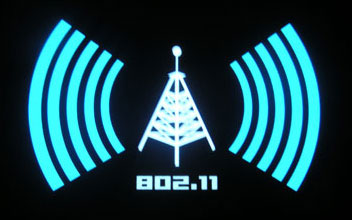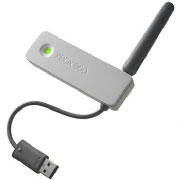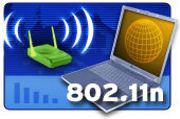6 ways to help upgrade WiFi network
TipsMake.com - According to Chris Kozup, Cisco's flexible solution marketing director, up to 4 out of 5 Cisco customers have had problems with their wireless network. Many of them have not been prepared to control the growth of phone devices - iPhones, Androids and now iPads - in the past few years.
He added: ' It took us three years to observe the growth of about 1 billion devices capable of connecting to Wifi and it took 5 years to witness the growth of 7 billion devices. Apple has been at the forefront of the manufacturing team when it launched a mobile browser experience that consumes bandwidth (at data level) really well with wireless networks .

Back a few years ago, and you will have no trouble finding employees with more than one phone device. They now have smartphones, laptops, and can be a barcode scanner or other wireless network devices. WiFi-based devices increasingly occupy an important place in the workplace. Kozup said: ' They are demanding an important mission .'
Kozup pointed out that up to 80% of Cisco customers had to do something to stabilize their wireless network, while 20% of other customers had stability.
Organizations within the higher education group and health care center tend to rely heavily on WiFi and therefore they are better prepared in the 'invasion' of the phone.
iPads and other WiFi-based devices also have a place inside hospitals, which is not surprising when nurses or doctors use them. Kozup said: ' In the hospital, there is a nurse call system, patient call system, heart rate monitor, . all are connected to WiFi . "
In another aspect, according to Kozup, financial services tend to be slow as they connect to upgrade WiFi networks to the most advanced technology devices. The reason is that concerns about security in WiFi networks are not much concerned. Low-tech devices also need to upgrade WiFi networks.
So, what should a CIO do to be able to upgrade WiFi? Cisco has advised users to focus on the 6 important things below:
1. Fill the coverage area
In the early days of WiFi, CIOs often place an access point in hot spot areas such as meeting rooms. The reason is because of the thinking that employees can disconnect their laptop computers from wired networks and bring them to the meeting room.
Today, employees tend to move a lot and attend meetings in many different places. They often need links and therefore, the need to have a reliable connection to the intranet is understandable. Kozup said: ' You will not need an internal network that will work well in the meeting room but lose the signal at a certain corner of the building '.
Cisco's advice : Configure 2.4 GHz for 20 MHz and 3 non-overlapping channels. Some organizations have proposed a 2.4 GHz configuration change into a 40 MHz support channel and a 20 MHz support channel. However, having 3 non-overlapping 20 MHz channels provides better network access and WLAN design more effectively than a 40 MHz channel and a 20 MHz channel. This configuration will help businesses deploy better wireless networks to optimize wireless reception and wireless coverage.
2. Receive weak signals?
Kozup said that older devices, such as those that do not support the latest wireless networking standard 802.11n, will be more difficult to capture from access points. Result: poor wave.
Cisco's advice : Take advantage of radio frequency reception technology to focus strong signal to older 802.11a / g products whenever they are connected to the network.
3. Eliminate obsolete technologies
According to Kozup: ' Let's face the problem, sometimes too old technologies need to be removed. Devices that support the first wireless networking standard - 802.11b - are really slow and reduce performance. We need to convince people to remove the old technology in their networks. By doing so, they were able to speed things up . '
Cisco's advice : Since most 802.11b standards are 'out of phase' compared to devices running 802.11g or 802.11a / g / n, Cisco recommends that all businesses turn off the data transfer rate below. 2.4 GHz in WLAN.
4. Working with higher frequencies

WiFi operates at 2 frequency levels: 2.4 GHz and 5 GHz. Most devices, including iPads, are dual-band devices capable of operating on both frequency bands. KoZup said: ' The truth of the problem lies in the 5 GHz frequency range is stronger and wider than the 2.4 GHz frequency band. Therefore, we need to make sure that these devices (iPads) are connected as close to the 5 GHz frequency range as possible . '
The problem is that dual-band devices tend to connect to the 2.4 GHz frequency range. Cisco has released a product called BandSelect that can automatically receive dual band devices and 'catch' them using a 5 GHz frequency band.
Cisco's advice : Because the 5 GHz frequency band is 8 times more spectrum than the 2.4 GHz band, and it's often less clumsy, Cisco BandSelect makes sure that devices can use the 5 GHz frequency band. . This also means that the 2.4 GHz band will be more widely available in both environments.
5. Is the phone device secure?
Does the iPhone, iPad, Android, and other mobile devices have a high level of security that helps to trust businesses? They can, when they are configured correctly with exact authentication protocols.
Cisco's advice : Some phone devices support 802.1x authentication in an enterprise environment. WiFi wireless network will be automatically displayed by each device or can be set under WiFi settings profile. The correct 802.1x method will be automatically selected for each wireless SSID or users can select them at Settings > WiFi > Security .
If there are no digital certification requirements, users only need to enter their user ID and password to gain secure access to the enterprise wireless network. If the validation method of businesses and organizations requires digital certification, IT will have to create configuration profiles and send them to mobile phone users.
6. Clean up the surrounding space

If you have experienced unpleasant working times when connecting to a slow WiFi network, this means that you should clean up the surrounding space. Microwave, cordless phones, Bluetooth-enabled devices, wireless speakers, etc. can be factors that cause frequency instability.
KoZup said: ' Pay attention to all Bluetooth devices in a business. They can be the cause of the workability of iPhone, iPad and Android devices in this environment . "
Cisco's advice : Cisco has a spectrum analyzer called CleanAir that detects and automatically reduces annoying frequencies by configuring the wireless network around the source of interference that enables devices to communicate. together in a clear universal access point.
You should read it
- Set up Ad Hoc wireless network to play WiFi without software from your laptop
- Advantages and disadvantages of Wifi and wired networks
- Review the Cisco RV180 VPN router
- Watch out for Wifi networks when using Android devices
- Instructions for use and security of Wifi network
- Cisco brought SDN to Amazon, the general cloud of Microsoft and Google
- How fast is Wifi 6?
- Connect your Windows 7 computer to the hidden Wifi network
May be interested
- 6 ways to network for routers (routers)
 even if the problem is a jittery network, you can't access the internet ... just a few simple steps will help you solve the problem of the router. here are a few ways you can follow to fix your internet glitches
even if the problem is a jittery network, you can't access the internet ... just a few simple steps will help you solve the problem of the router. here are a few ways you can follow to fix your internet glitches - 9 basic steps to replace, upgrade Wifi card on Laptop
 if your computer's internet access speed is slow or interrupted. the first thing you should think about is to replace the new wifi card. if you do not know how to replace yourself, upgrade your wifi card, and refer to the article below.
if your computer's internet access speed is slow or interrupted. the first thing you should think about is to replace the new wifi card. if you do not know how to replace yourself, upgrade your wifi card, and refer to the article below. - How to speed up Wifi network, increase WiFi signal
 how to speed up wifi network, increase wifi signal to the highest level will help stabilize wifi network, better capture wifi for devices connected to wifi network. invite you to consult!
how to speed up wifi network, increase wifi signal to the highest level will help stabilize wifi network, better capture wifi for devices connected to wifi network. invite you to consult! - How to manage wifi network in Windows 7
 with windows 7, microsoft has made a major upgrade in managing wi-fi networks. if you consider the development of wireless networks within the last 5 years, you will find this upgrade really relevant. therefore, this article will show you how to manage wireless networks with changes in windows 7 operating system.
with windows 7, microsoft has made a major upgrade in managing wi-fi networks. if you consider the development of wireless networks within the last 5 years, you will find this upgrade really relevant. therefore, this article will show you how to manage wireless networks with changes in windows 7 operating system. - Several ways to improve Wi-Fi connection
 wi-fi wireless network is one of the biggest utilities of using a laptop instead of bulky desktops. instead of having to sit around all the time to keep away from the range of the network, you can carry your laptop across the room and still be able to surf the web comfortably.
wi-fi wireless network is one of the biggest utilities of using a laptop instead of bulky desktops. instead of having to sit around all the time to keep away from the range of the network, you can carry your laptop across the room and still be able to surf the web comfortably. - Instructions for use and security of Wifi network
 wireless networks are one of the great inventions of the 21st century. instead of using cables to connect computers and devices together, you can now use radio waves to connect. this technology has been widely known as 'wifi'. once set up correctly, wifi will not encounter any problems.
wireless networks are one of the great inventions of the 21st century. instead of using cables to connect computers and devices together, you can now use radio waves to connect. this technology has been widely known as 'wifi'. once set up correctly, wifi will not encounter any problems. - How to set up Wifi priority mode on Android and iPhone
 wifi has become popular, you can even use different services to find free wi-fi hotspots near you. although this is very beneficial, it also means there are too many competing signals in the same space. so how to set up wifi network priority on smartphone? read this article and find the answer!
wifi has become popular, you can even use different services to find free wi-fi hotspots near you. although this is very beneficial, it also means there are too many competing signals in the same space. so how to set up wifi network priority on smartphone? read this article and find the answer! - How to hack your own WiFi network
 one way to increase your understanding of wifi security is to try to hack the network. but you absolutely should not intrude on the company or neighbor's network.
one way to increase your understanding of wifi security is to try to hack the network. but you absolutely should not intrude on the company or neighbor's network. - The most effective way to fix errors in computers and laptops that cannot connect to wifi
 there are many possible reasons why you cannot connect to wifi, the device reports a wifi error, or connects to the network. common fixes such as resetting the wifi modem or connecting to another wifi network can fix this problem. however, when the above methods are not effective, you can refer to the most effective ways to fix errors of computers and laptops not connecting to wifi compiled by tipsmake below.
there are many possible reasons why you cannot connect to wifi, the device reports a wifi error, or connects to the network. common fixes such as resetting the wifi modem or connecting to another wifi network can fix this problem. however, when the above methods are not effective, you can refer to the most effective ways to fix errors of computers and laptops not connecting to wifi compiled by tipsmake below. - Secure WiFi in enterprise environment from basic steps
 wifi is an entry-point (an entry point) that hackers can use to infiltrate your network without stepping into your company's headquarters, because wireless networks are more vulnerable to eavesdropping than wired networks. this makes network administrators more diligent in the security of wifi networks.
wifi is an entry-point (an entry point) that hackers can use to infiltrate your network without stepping into your company's headquarters, because wireless networks are more vulnerable to eavesdropping than wired networks. this makes network administrators more diligent in the security of wifi networks.










 How to detect iPhone 4 'build up'
How to detect iPhone 4 'build up' View all video file formats with VLC for iPhone or iPod
View all video file formats with VLC for iPhone or iPod Experience with the CopyTrans Suite application
Experience with the CopyTrans Suite application Instructions for connecting from iPhone to Exchange account
Instructions for connecting from iPhone to Exchange account Control the remote computer via iPhone or iPod Touch
Control the remote computer via iPhone or iPod Touch Google Maps has supported navigation in Vietnam
Google Maps has supported navigation in Vietnam